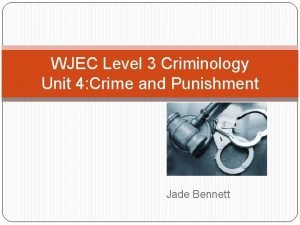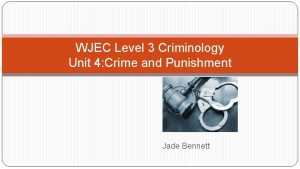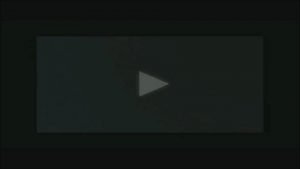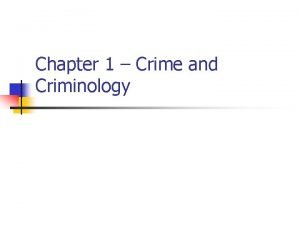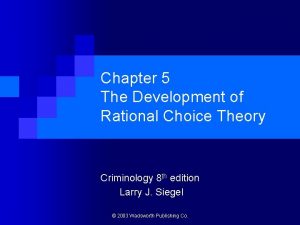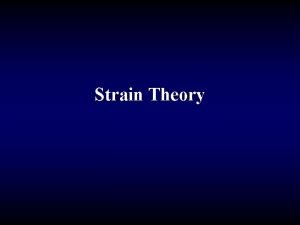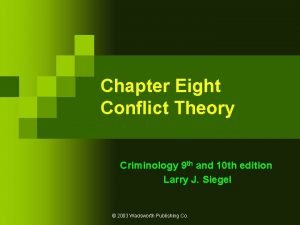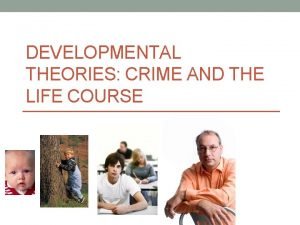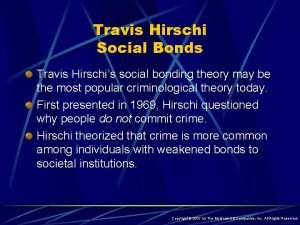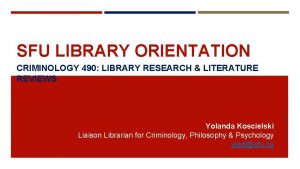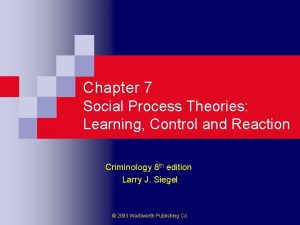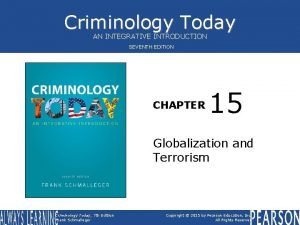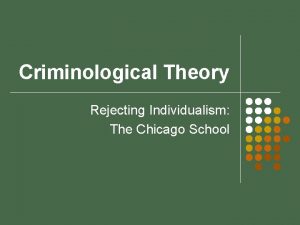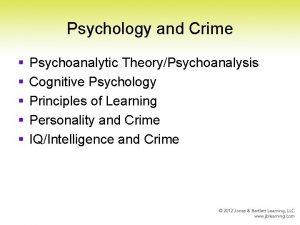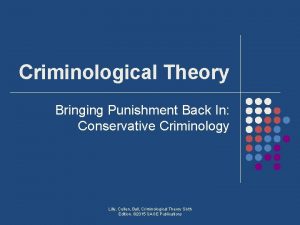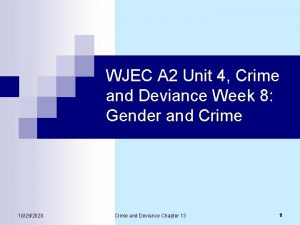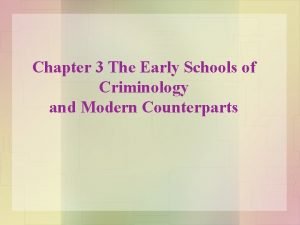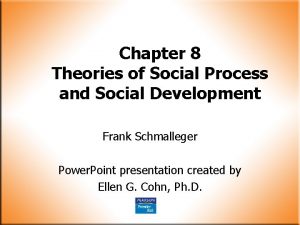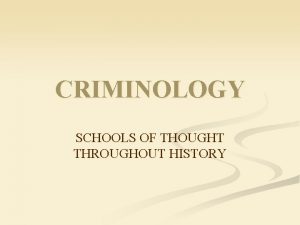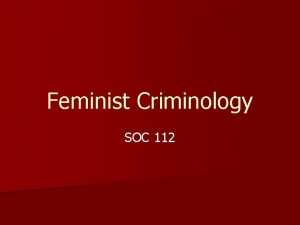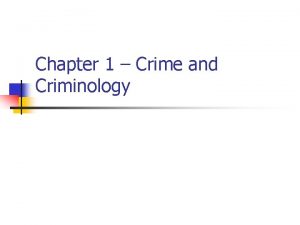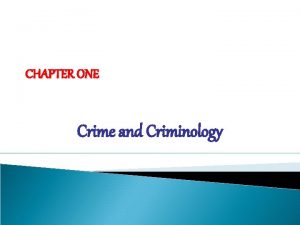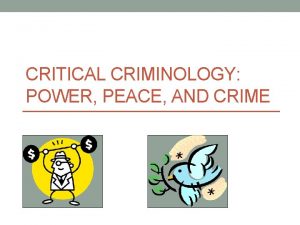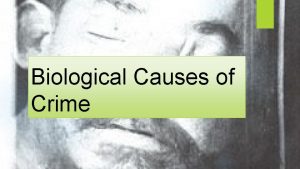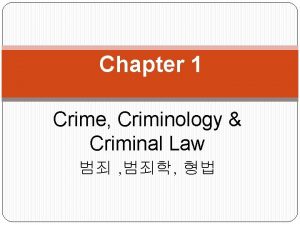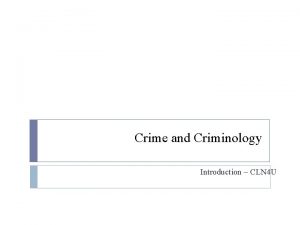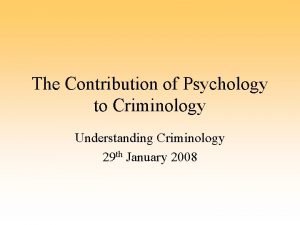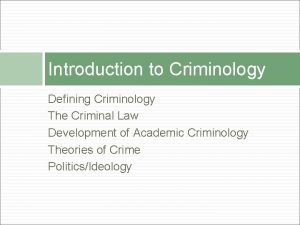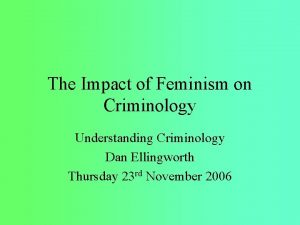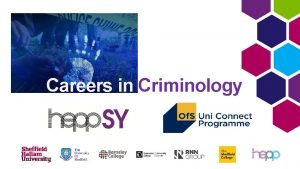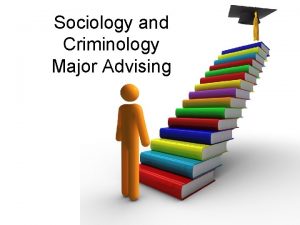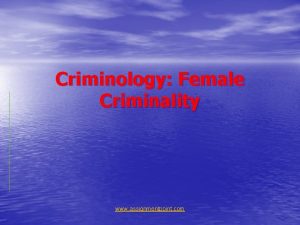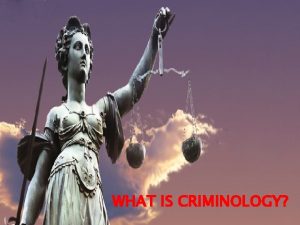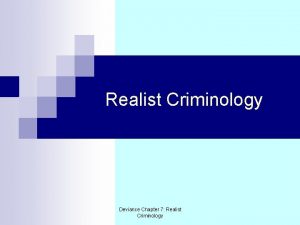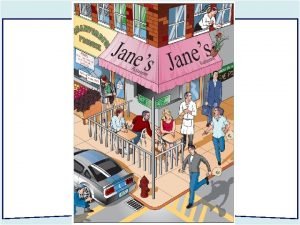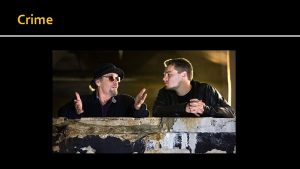Causes of Crime What is Criminology Criminology The





































































- Slides: 69

Causes of Crime

What is Criminology? • Criminology – The scientific study of crime and the causes of criminal behavior. • Criminologists – A specialist in the field of crime and the causes of criminal behavior.

Moral Dilemma 2 • Find your new seat.

What determines if a drug is illegal? • Mala in se: crimes that inherently wrong. – Murder, Rape, Theft • Mala prohibita: acts that legislation determines are illegal, but that may not be necessarily wrong in and of themselves. • Often public order crimes/victimless crimes

CONSENSUS MODEL • Based on what the majority views to be acceptable behavior in a society. • Based on norms and values. • Assumes that a diverse group of people can have similar values. • In this model Laws change as ideas about “right” and “wrong” change.

CONFLICT MODEL • Recognizes that disagreements on norms exist between people and come in conflict. • The most politically powerful segments of society based on class, income, age, and race have the most influence on criminal laws and impose their values on the rest of the community. • Laws reflect the values of groups holding power at a given time.

What is a crime?

What is a Crime? • An punishable action that violates criminal law as determined by the majority or a powerful minority.

What are the risk factors of criminal behavior?

• Criminologists attempt to discover – Correlations – relationships between variables in which they vary together. What factors are related to crime? – Causation – a relationship where one variable causes a change in another. What factors cause crime?

Choice Theory • Criminals weigh the benefits of their actions against the expected costs of being caught. • When the benefit is greater than the costs the criminal will make a rational CHOICE to commit an act. • Can anyone think of examples of this being the case?

Positivism • Argues that criminal behavior is the result of biological, psychological, and social factors. • These external forces help predict crime. • Criminals should be punished, but treated to lesson the impact of these factors.

Biological Factors • Twin Studies: Comparing the criminal activity of identical twins to fraternal twins. • Data does support rates of criminality among identical twins raised in different environments that is closer to that of their biological parents.

Biological Factors • Hormones: testosterone has been associated with traits of aggression. Violent criminals have higher testosterone levels. • Can also be seen in females: postpartum psychosis.

Biological Factors • Brain factors: Neurotransmitters – Low Serotonin – High Norepinephrine • • • Mirror Neurons Damage/Underdevelopment of Frontal Lobe Cysts/Lesions/Tumors Low Blood Sugar Neurotoxins

Psychological • Cognitive – The way they see the world. • Psychoanalytical – Past experiences that unconsciously impact current behavior stemming from childhood. • Behavioral – Rewards and punishments of the environment shape current behavior

Psychodynamic Theory Repression, Childhood Relationships, Trauma, the Unconscious.

Social Factors • Social Disorganization Theory: deviant behavior is more likely in communities where institutions like the family, school, church, or criminal justice system fail to exert control. • Single parent homes.

Social Factors • Strain Theory: Crime is the result of frustration caused by individuals not being able to reach their personal goals through legitimate socially acceptable means. • Drug dealing, Pedophiles, Bank Robbers, Rapists

Cultural Deviance Theory • Marginalized groups may feel that the social norms and society in general does not share its values or look out for their well being, so the values of dominant culture are rejected.

Social Process Theory • The Power of Situations and the interaction of individuals with their environment is a key contributor to crime. • We are all capable of crime.

Learning Theory • Argues that delinquents are taught both the practical and emotional skills needed to participate in illegal activity. • Observational learning: Bandura: Aggression can be modeled and repeated.

Crime Theories Practice

Drug Use and Crime • Drug Abuse- use that is physically or psychologically harmful. • 7 -20% of users become abusers. • More than 2/3 of inmates are dependent or abuse drugs. • More than 1/3 were actually under the influence at the time of arrest.

Drug Use and Crime • Psychopharmacological model: the criminal acts are the direct result of the drugs. • Economically impulsive model: the criminal acts are the result of attempts to purchase drugs. • Systemic Model: crime is a byproduct of the unregulated and relationship of the drugusing community.

How should we treat drug crimes? • Medical Model: addicts are not criminals, but mentally or physically ill and forced into crime to feed a habit. • Criminal Model: drug addicts/abusers are a danger to society and should be punished the same way non drug users would be for committing crime.

Drugs and Crime • About 20 million Americans use illicit drugs • About 200 million Americans use licit drugs. • Illicit: drugs whose sale/consumption have been made illegal. • Licit: socially acceptable drugs

SPICE and K 2

Bath Salts & Flakka

Grab a laptop • Assignment Directions.

Crime Rates • What type of factors do you think correlate with high crime rates?



Uniform Crime Report (UCR) • • Developed in 1930. Produced by the FBI Organizes “offenses known by police” Relies on voluntary participation of local state and federal law enforcement agencies.

Uniform Crime Report (UCR) • Based on 3 measurements – The numbers of persons arrested – The number of crimes reported by victims, witnesses, or the police. – The number of officers and support law enforcement specialists. – Presented as a rate per 100, 000 people – As a percentage change from previous year – As a total number of crimes

Is there a difference between the crime rate and crime in America?

PART I OFFENSES • Murder – Nonnegligent manslaughter – Mansluaghter b 6 y negligence • Forcible Rape • Robbery • Aggravated Assault- attempt to cause serious harm- usually involving a weapon. • Burglary (Breaking and Entering) • Larceny (theft) • Motor Vehicle Theft • Arson (Fire Setting)

PART II OFFENSES 5 X • • • Curfew & Loitering • Disorderly Conduct • DWI Drug Abuse Violations • • Drunkenness • Embezzlement • Forgery • Fraud • Gambling Liquor Law Violations • Offense against Family and Children Simple assaults Prostitution Runaways -18 Sex Offenses Stolen Property Vagrancy Vandalism Weapons

Federalism • A form of government in which there is a division of powers between a central government and smaller regional governments • In the United States this is the Federal government and State and Local governments • Law Enforcement- Local, State, and Federal

What is the most dangerous state in the country?

The Wedding Cake Model • Explains how different cases receive different treatment in the criminal justice system • Cases at the top receive the most attention, cases at the bottom are disposed of quickly and mostly ignored.

Celebrity cases that attract the most attention and publicity. Ordinary felonies, less violent crimes, Usually first time offenders “High Profile “, committed by people with criminal records, where victims were harmed, and a weapon was used. Misdemeanors and petty offenses

Dark Figure of Crime • A term used to describe the actual amount of crime that takes place

Arthur Shawcross • Discuss how the following theories would explain Arthur's behavior: – Choice Theory – Positivism – Psychoanalytic Theory – Strain Theory – Learning Theory

Why use Choice Theory? • Classical Criminology uses Choice Theory – Offenders make the choice to commit crime. – Offenders weigh the expected costs of offending against the expected benefits of offending. – Swift and certain punishment is the most powerful deterrent to criminal offending.

Utilitarianism • Jeremy Bentham’s Theory of Utilitarianism states that punishment should have 4 goals: – To prevent all crime. – When it cannot prevent crime, to assure that a criminal will commit a lesser crime to avoid harsher punishment. – To give the offender the incentive not to harm others in the pursuit of crime. – To prevent crime at the least possible cost to society.

Positivism vs. Classical Criminology

Positivism • Positivism – Criminal behavior is determined by biological, psychological, and social forces beyond the control of the individual. – Cesare Lombroso is the “Father of Criminology. ” – Rehabilitation and treatment are the only deterrent to criminal offending.

Classical Criminology • Modern Choice Theory – James Q. Wilson’s rational choice theory. – Jack Katz’s seduction of crime theory. • Choice Theory and Public Policy – The best deterrent to crime is severe punishment.

Trait Theories • Trait Theories – Suggest there are biological and psychological causes of crime. • Biology is the scientific study of living organisms. • Psychology is the study of the mind.

Trait Theories • Biological influences on crime include the study of – – Genetics and crime. Hormones and aggression. The brain and crime. The impact of chemical imbalances on behavior. • Psychological influences on crime include the study of – Freud’s psychoanalytic theory as it relates to crime. – Social psychology and “evil” behavior.

Trait Theory within Society • Trait Theory and Public Policy – Antisocial behavior should be identified and treated before it manifests itself into criminal behavior.

Theories of Social Structure to Explain Crime

Sociological Theories • Social disorganization theory • Strain theory • Cultural deviance theory – Social Structure Theory and Public Policy • Changing neighborhoods conditions can prevent crime.


Learning Objective 5: List and briefly explain the three branches of social process theory.

Social Process Theories • Social Process Theories – Learning Theory – Control Theory – Labeling Theory • Social Process Theory and Public Policy – Crime prevention focuses on juvenile offenders and steering them away from offending and the system.

Social Conflict Theories • Social Conflict Theories – Marxism versus Capitalism – The Social Reality of Crime – Issues of Race and Gender • Social Conflict Theory and Public Policy – Given its radical nature, this theory has a limited impact on public policy.



Course Criminology • Life Course Theories – Self-Control Theory – Continuity Theory of Crime • Life-Course Persisters • Adolescent-Limited

Offenders and Victims • Victimology – The Risks of Victimization – Routine Activity Theory • Suitable Target • Motivated Offender • Absence of a Guardian – Repeat Victimization – The Victim-Offender Connection


Learning Objective 8: Contrast the medical model of addiction with the criminal model of addiction.

Medical Addiction vs. Criminal Addiction • The Criminology of Drug Use: – Social Disorganization Theory – Subculture Theory – Drugs and the “Learning Process” • Learn the techniques of drug use • Learn to perceive the pleasurable effects of drug use • Learn to enjoy the social experience of drug use

Addiction • Drug Addiction and Dependency – Drug Use versus Drug Abuse – Addiction Basics • The role of dopamine in the brain • Nerve endings called receptors • Physical dependence and withdrawal

Addiction • Models of Explanation – The Psychopharmacological Model – The Economically Impulsive Model – The Systemic Model • Models of Addiction – The Medical Model of Addiction – The Chemical Model of Addiction

ABC Video: Gang Prevention

Chronic Offender • Wolfgang’s Chronic Offender – A small group of offenders, 6%, are responsible for a disproportionate amount of crime. – Habitual offenders laws provide harsher sentences for repeat offenders.
 Wjec unit 4 criminology
Wjec unit 4 criminology Criminology unit 2
Criminology unit 2 Wjec criminology past papers unit 4
Wjec criminology past papers unit 4 Wjec criminology unit 4 advanced information
Wjec criminology unit 4 advanced information Ultimate and proximate causes of behaviour
Ultimate and proximate causes of behaviour Proximate behaviour in animals
Proximate behaviour in animals ưu thế lai là gì
ưu thế lai là gì Hệ hô hấp
Hệ hô hấp Các môn thể thao bắt đầu bằng tiếng nhảy
Các môn thể thao bắt đầu bằng tiếng nhảy Tư thế ngồi viết
Tư thế ngồi viết Cái miệng bé xinh thế chỉ nói điều hay thôi
Cái miệng bé xinh thế chỉ nói điều hay thôi Hình ảnh bộ gõ cơ thể búng tay
Hình ảnh bộ gõ cơ thể búng tay Cách giải mật thư tọa độ
Cách giải mật thư tọa độ Tư thế ngồi viết
Tư thế ngồi viết Thẻ vin
Thẻ vin Thứ tự các dấu thăng giáng ở hóa biểu
Thứ tự các dấu thăng giáng ở hóa biểu Gấu đi như thế nào
Gấu đi như thế nào Thể thơ truyền thống
Thể thơ truyền thống Các châu lục và đại dương trên thế giới
Các châu lục và đại dương trên thế giới Khi nào hổ con có thể sống độc lập
Khi nào hổ con có thể sống độc lập Từ ngữ thể hiện lòng nhân hậu
Từ ngữ thể hiện lòng nhân hậu Thế nào là hệ số cao nhất
Thế nào là hệ số cao nhất Diễn thế sinh thái là
Diễn thế sinh thái là Vẽ hình chiếu vuông góc của vật thể sau
Vẽ hình chiếu vuông góc của vật thể sau Frameset trong html5
Frameset trong html5 Làm thế nào để 102-1=99
Làm thế nào để 102-1=99 Lời thề hippocrates
Lời thề hippocrates Tư thế worm breton
Tư thế worm breton đại từ thay thế
đại từ thay thế Quá trình desamine hóa có thể tạo ra
Quá trình desamine hóa có thể tạo ra Cong thức tính động năng
Cong thức tính động năng Thế nào là mạng điện lắp đặt kiểu nổi
Thế nào là mạng điện lắp đặt kiểu nổi Khi nào hổ con có thể sống độc lập
Khi nào hổ con có thể sống độc lập Dot
Dot Nguyên nhân của sự mỏi cơ sinh 8
Nguyên nhân của sự mỏi cơ sinh 8 Bổ thể
Bổ thể Vẽ hình chiếu đứng bằng cạnh của vật thể
Vẽ hình chiếu đứng bằng cạnh của vật thể Phản ứng thế ankan
Phản ứng thế ankan Thiếu nhi thế giới liên hoan
Thiếu nhi thế giới liên hoan Hát lên người ơi alleluia
Hát lên người ơi alleluia điện thế nghỉ
điện thế nghỉ Một số thể thơ truyền thống
Một số thể thơ truyền thống Trời xanh đây là của chúng ta thể thơ
Trời xanh đây là của chúng ta thể thơ Số nguyên là gì
Số nguyên là gì đặc điểm cơ thể của người tối cổ
đặc điểm cơ thể của người tối cổ Tỉ lệ cơ thể trẻ em
Tỉ lệ cơ thể trẻ em Vẽ hình chiếu vuông góc của vật thể sau
Vẽ hình chiếu vuông góc của vật thể sau Các châu lục và đại dương trên thế giới
Các châu lục và đại dương trên thế giới Pamantasan ng lungsod ng marikina hymn
Pamantasan ng lungsod ng marikina hymn What is criminology?
What is criminology? Rational choice theory criminology
Rational choice theory criminology What is strain theory
What is strain theory Conflict theory criminology
Conflict theory criminology Developmental theory criminology examples
Developmental theory criminology examples Social bonds travis hirschi
Social bonds travis hirschi Robert napper criminology
Robert napper criminology Sfu databse
Sfu databse Primary and secondary deviance
Primary and secondary deviance Criminology today 7th edition
Criminology today 7th edition Criminology unit 1
Criminology unit 1 Chicago school of criminology
Chicago school of criminology Psychoanalytic theory criminology
Psychoanalytic theory criminology Conservative criminology
Conservative criminology Wjec criminology unit 4 exam 2020
Wjec criminology unit 4 exam 2020 Neoclassicism criminology
Neoclassicism criminology Diagnostic imaging uwe
Diagnostic imaging uwe Social process theories criminology
Social process theories criminology Schools of thought in criminology
Schools of thought in criminology Feminist theory criminology
Feminist theory criminology Neoclassical criminology essay
Neoclassical criminology essay
